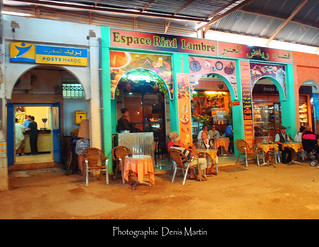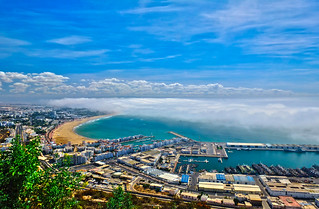Agadir (also known as ‘Santa Cruz do Cabo de Aguer’) is a major Berber city located on the shore of the Atlantic Ocean, near the foot of the Atlas Mountains where the Sous River flows into the ocean. Historically there is little known about the city before the 12th century.
The oldest cartographic mention of Agadir is on a map dated from 1325 of a place called ‘Porto Mesegina’ (named after a Berber tribe called ‘the Mesguina’) at the approximate the same location of the modern city. At the end of the medieval period, Agadir was a town of some importance. The name itself, ‘Agadir el-arba’, was attested to for the first time in 1510.
In 1505, the Portuguese founded a trading post and a fort ‘Santa Cruz do Cabo de Aguer’. Shortly after, the Portuguese were exposed to the hostility of the tribes of the region. In 1541, ‘Sherif Saâdien Mohammed ash-Sheikh’ captured the fortress of ‘Santa Cruz’ and in 1572, he built a kasbah on top of a mountain. The place was now called ‘Agadir Oufella, Agadir le haut, Agadir N’Ighir, or Agadir de la colline’ (which stands for fortified granary of the hill in Tachelhit). In the 17th century, during the Berber ‘Tazeroualt’ dynasty, Agadir was an important harbour and traded mainly in sugar, wax, copper, hides, and skins.
Under Sultan ‘Moulay Ismail’ and his successors, they trade with France, England, and the Netherlands. In 1731, the town was completely destroyed by an earthquake. In 1746, the Dutch set up a trading post at the foot of the Casbah under the authority of the Sultan, and undoubtedly participated in the restoration of the city. Above the door of the Casbah, the Dutch inscription can still be seen with its transcription in Arabic: ‘Vreest God ende eert den Kooning’, which means ‘Fear God and honour the King’.
Source picture (with kind permission): T. Baran
After a long period of prosperity (under the Saadian and Alawite dynasties), Agadir declined from 1760 into a sort of ghost town, because of the pre-eminence given to the port of Essaouira, which lasted a one and half century. In 1881, Sultan ‘Moulay Hassan’ reopened the harbour to trade. After an earthquake in 1960, there remained only a restored long high wall of the old fortress.
In 1913, the cities (Agadir N’Ighir and Founti) totalled less than a thousand inhabitants. After 1920, under the French protectorate, a large port and a modern central city began to be built according to the plans of the French. After 1950 and the opening of the new commercial port, the city grew with fishing, canning, agriculture, and mining. It also began to open up to tourism thanks to its climate, beautiful hotels, and sandy beaches.
Picture 2: Sea of clouds on Agadir’s Bay
With its white buildings, wide flowered boulevards, modern hotels, and European style cafes, Agadir is not a typical city of traditional Morocco. It is nowadays a modern, active, and dynamic city. The bay of Agadir and the nearby ‘Bay of Taghazout’ are one of the most beautiful bays in the world.
Agadir is part of the tourism region ‘Souss Sahara Atlantique‘ of Morocco.
Source pictures 1 and 3 (with kind permission): Denis Martin
Source picture 3 (with kind permission): Michael Bourgeois







